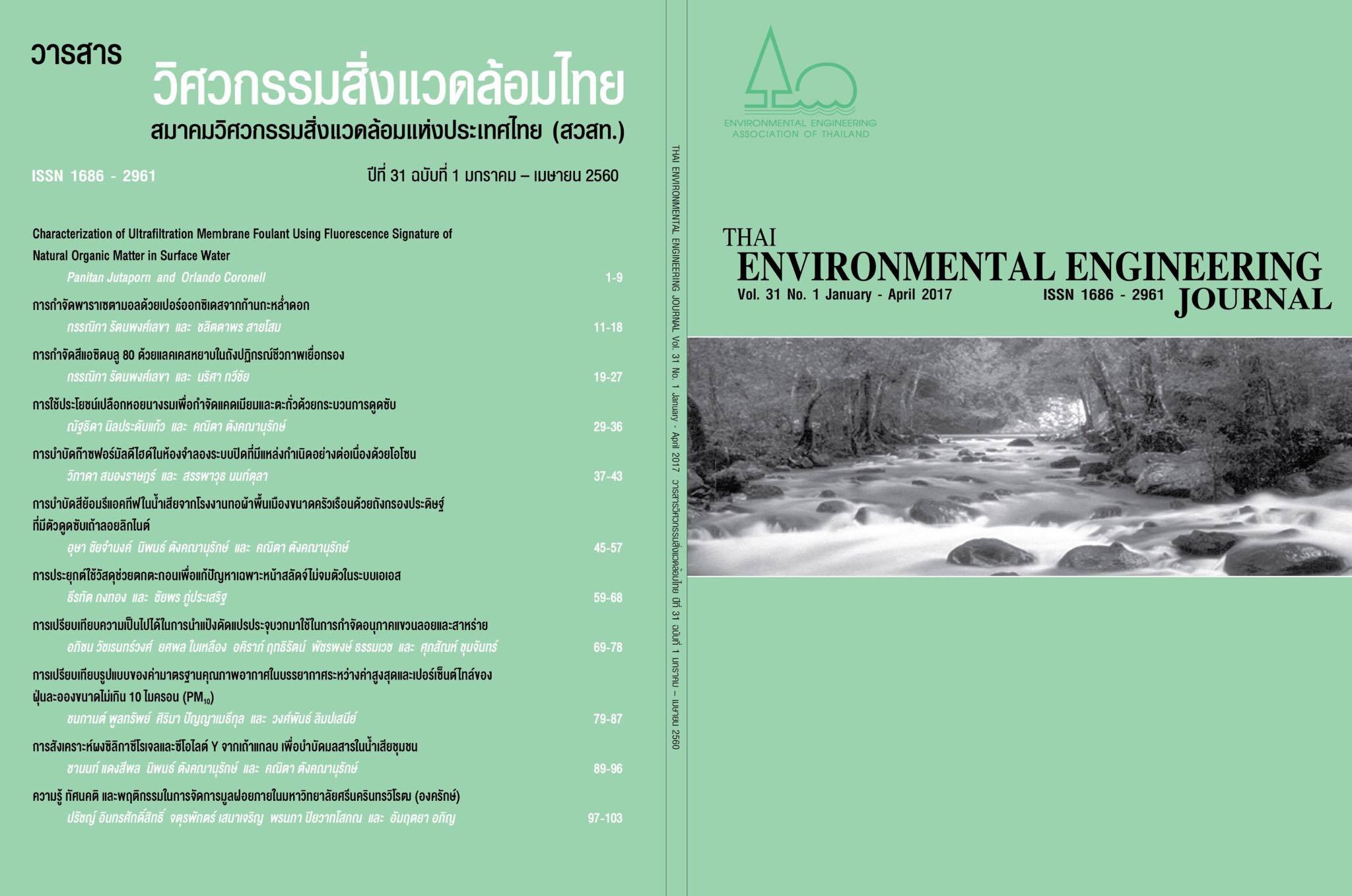The Utilization of Oyster Shells to Eliminate Cadmium and Lead by Adsorption Process
Main Article Content
Abstract
This research aims to utilize 2 species of oyster shells namely Crassostrea belcheri and Crassostrea lugubris which are large amount of original waste at Suratthani. Due to the physical and chemical propoties, oyster shells 2 species were used as 2 hazardous heavy metals adsorbents (Cd and Pb). Batch experimental results revealed that the adsorption efficiency of the Cd and Pb by oyster shells size > 2 mm. in 10 mg/L of each metal solution were more than 90% at the optimum conditions (4 g of oyster shells, shaking speed 120 rpm at 60 min and contact time 90 min). Adsorption capacity of Crassostrea belcheri and Crassostrea lugubris were 0.1134 and 0.1133 mg-Cd/g respectively 0.1129 and 0.1123 mg-Pb/g respectively. The mechanism adsorption was conformed to Langmuir and Freundlich isotherm. In addition two group experimental designs, the column experiments were performed in glass column (6.3 cm.i.d × 41 cm.h) packing with 500 g of oyster shells and performed in plastic tank size (10 L) capacity packing with 5,000 g of oyster shells. The result from glass column revealed that the breakthrough point and exhaustion point of Crassostrea lugubris were higher than the other species. Moreover, the Cd and Pb removal efficiency in synthetic wastewater, at 1st time of treatment, the Cd and Pb removal efficiency of Crassostrea belcheri were 99.80% and 100.00% respectively. The breakthrough point and exhaustion point were 92 L are 148 L respectively. In the other way of application of oyster shells shells was investigated by using 2 species of oyster shells size < 2 mm. From jar test experimental results, the Cd and Pb removal efficiency were less than the batch experiments. The Cd and Pb removal efficiency of Crassostrea belcheri in 20 L of synthetic wastewater of agitating time 120 rpm at 60 min and contact time 90 min were 75.89% and 78.48% respectively. Therefore, the 2 species of oyster shell could be considered to apply for Cd and Pb elimination in wastewater.
Article Details
References
[2] Chaipetch, W. 2013. Size of the Shells Optimal in Efficiency of Total Kjeldahl Nitrogen and Phosphorus Removal from Shrimp Farming Effluent. A Thesis for Degree of Master of Science and Technology in Environmental Science. Suratthani Rajabhat University. (in Thai)
[3] Srikittichaikul, P. 2009. Efficiency of Oyster Shell Media to Treat Acidic Wastewater in Anaerobic Filter Tank. A Thesis for Degree of Master of Engineering in Environmental Engineering. Chulalongkorn University. (in Thai)
[4] US EPA. 1992. Standard method 1331 Toxicity Characteristic Leaching Procedure (pdf file). Available Source: www.epa.gov/osw/hazard/testmethods/sw846/pdfs/1311.pdf, December 25, 2015.
[5] Pollution Control Department. 2004. Set standards for Controlling the Discharge of Industrial and Industrial Wastewater No. 3 (1996). http://www.pcd.go.th/info_serv/reg_std_water04.html, August 12, 2016. (in Thai)
[6] Jung, J.H., Shon, B.H., Yoo, K.S. et al. 2000. Physicochemical Characteristics of Waste Sea Shells for Acid gas Cleaning Absorbent, Korean Journal of Chemical Engineering, 17: 585-592.
[7] Tungkananuruk, N. and Tungkananuruk, K. 2007. Principle of Chemical Water Quality Analysis. 1st ed. Kasetsart University, Bangkok. (in Thai)
[8] Jadamara, B., Chaiyam, N. and Phadungsap, L. 1997. General Chemistry 2. Aksorncharoentat, Bangkok. (in Thai)
[9] Naranong, D. and Chandraambhorn, W. 2012. Utilization of the Chemicals Derived from Oyster Shells in the Reduction of Heavy Metal and Phosphate Contents in Waste water. The Thailand Research Fund, Bangkok. (in Thai)


